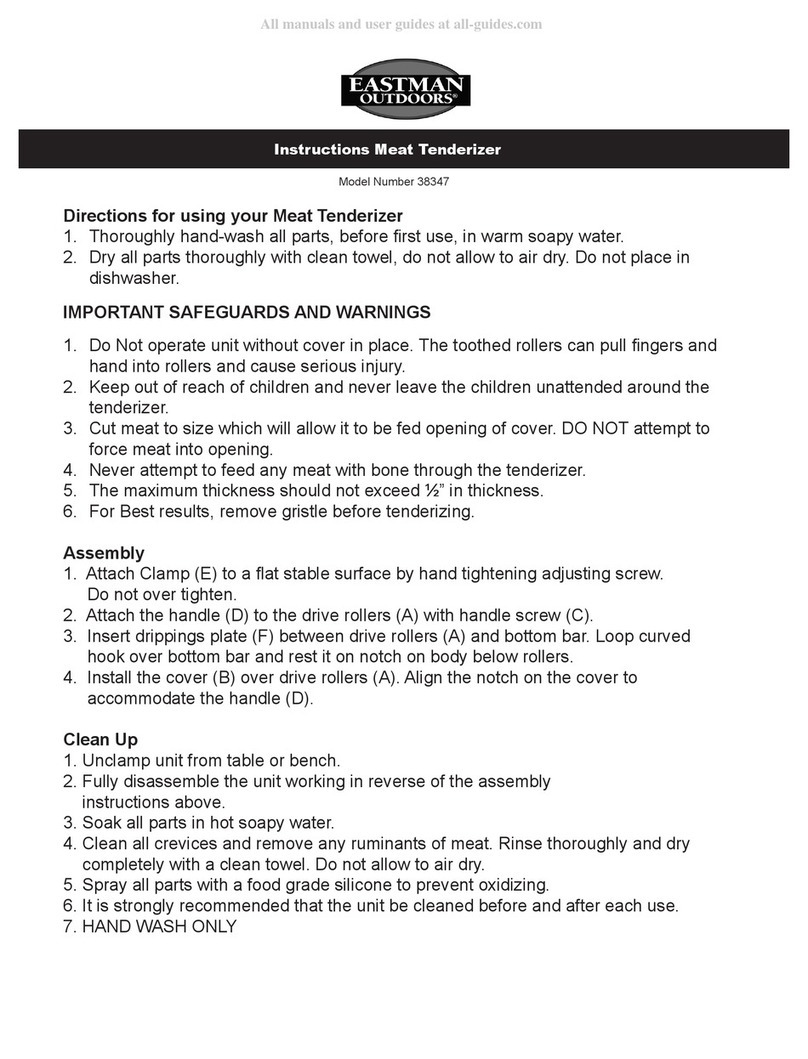
8
same amount of time. It is best to cut strips across the grain to produce
jerky that is easier to break apart and chew.
Add delicious Eastman Outdoors®jerky cure and seasonings which
are available in a large variety of avors or your own cure and recipe
marinade for a minimum of 4 to 8 hours in the refrigerator before drying.
The longer you marinate the meat, the more avorful the jerky. If you
use your own recipe, be sure to use a cure and spice combination that
includes salt (Sodium Nitrite) to prevent bacterial growth during the
initial stages of drying.
You can make delicious jerky from ground game meat, using the
Eastman Outdoors®Jerky and Sausage Gun Kit and our large variety of
delicious seasoning packs.
When making jerky from wild game meats, be sure to dry it at the
highest temperature setting. Pat jerky with clean paper towels several
times during the drying cycle to remove any oils that accumulate on
the top of the jerky. When removing jerky from dehydrator trays, wrap
slices in paper towels so excess fat can be absorbed which will help to
increase storage shelf life.
CAUTION: Finally, after dehydrating, heat all of the meat slices in your
oven at a minimum temperature of 165°F for at least 30 minutes as a
precaution against the risk of parasites such as salmonella.
JERKY USING MEATS OR POULTRY - DRY AT HIGHEST SETTING
Jerky can also be made from a variety of other meats and poultry. When
purchasing meats for jerky, choose freshly butchered and lean meats
with minimal marbling (fat), as fat tends to go rancid during storage. A
lean cut of ank steak or round steak makes excellent jerky.
To make jerky from ground meat, choose freshly ground 85% to 90%
lean ground meat. Ground meat jerky is easier to make, dries faster,
and is less expensive and easier to chew than jerky slices.
Add the delicious Eastman Outdoors®jerky cure and seasonings or
your own cure and recipe marinade for 4 to 8 hours in the refrigerator
before drying. The longer the meat marinates, the more avorful the
jerky. If you use your own recipe, be sure to use a cure and spice
combination that includes salt (Sodium Nitrite) to prevent bacterial
growth during the initial stages of drying.
Be sure to dry meats and poultry at the highest temperature setting.
CAUTION: Finally, after dehydrating, heat all of the meat slices in your
oven at a minimum temperature of 165°F for at least 30 minutes as a
precaution against the risk of parasites such as salmonella.
STORAGE OF YOUR JERKY
Jerky that is stored un-refrigerated will start to go rancid at room
temperature after 3 to 4 weeks. Refrigerate or freeze for longer storage
or until you are ready to consume. If any ice crystals have formed inside
the storage bag or container, re-package in a dry container. If jerky is
dried thoroughly, it will last for several weeks un-refrigerated. All types
of jerky must be dried sufciently to avoid mold. If mold is found inside a










































